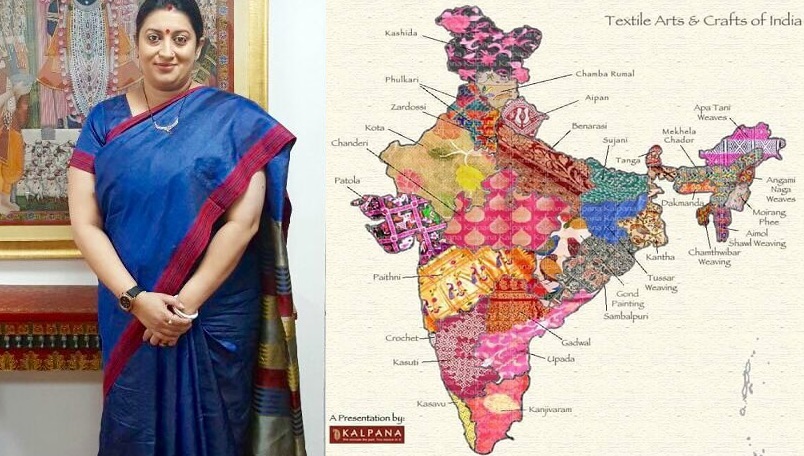By Preeti Zachariah
Mint, New Delhi
WWR Article Summary (tl;dr) A campaign to support Indian weavers and their products has gone viral with around 3,700 shares and 6,772 likes in less than 24 hours. Mint takes a look at why the campaign #IWearHandloom is so popular and what are some of the more interesting weaves in India.
BANGALORE
A day after Union minister of textiles Smriti Irani posted a picture of herself on Twitter in a periwinkle blue silk sari with a deep red border, stating that it was her #IWearHandloom look and tagging four more people including Anandiben Patel, Devendra Fadnavis, Shivraj Singh Chouhan and Kiran Bedi the campaign to support Indian weavers and their products has gone viral with around 3,700 shares and 6,772 likes in less than 24 hours.
As Twitterati continues to be besieged with photographs of handloom enthusiasts in their favourite hand woven outfits, Mint features some of the best-known weaves of India.
Kanjeevaram silk: Legend goes that the weavers from the temple town of Kancheepuram in Tamil Nadu are the descendents of sage Markanda, the weaver for the Gods. Woven from pure mulberry silk, the opulent jewel-coloured weave with its heavy contrasting border, threaded through with real silver and gold finds itself in the trousseau of almost every South Indian bride. Woven on a three-shuttle loom, the weave that usually carries motifs inspired from temples and nature, is a favourite of Bollywood actors Rekha and Vidya Balan.
Phulkari: Phulkari features in one of Punjab’s most famous star-crossed love stories–Waris Shah’s Heer Ranjha. Heer’s trousseau is believed to have contained the handspun khaddar on which floral patterns were embroidered using a simple darn stitch. It was a rite of passage in Punjab–when a girl child was born, the women of the house would start embroidering a fabric, and the garment would be carried by the girl when she became a Punjabi bride and left her maternal home. Today, Phulkari is barely available in its original form and is made usually by machine.
Ikkat: The technique which involves resist dyeing on yarn multiple times before it is woven, creating a varicoloured blurry textile is practised in several states in India, including Gujarat, Telangana and Orissa. One of the oldest weaves in the world, it is also found in Japan, Indonesia, Cambodia, Bolivia and Thailand. A versatile technique, it lends itself to a variety of garments, including saris, stitched clothes and home furnishing.
Paithani: Hand-woven in the Paithan town of Aurangabad, Maharashtra, the Paithani is made of the finest of silk and gold threads. The bright colours, oblique square designs on its borders and distinctive motifs on the pallu, including peacocks, parrots and flowers, set it apart. The weave uses the ancient technique of tapestry where multiple threads are woven together to form the magnificent whole.
Banarasi: It is said that when Buddha attained nirvana, the shroud used to wrap his body was made of the finest of hand woven brocade from Banaras. The holy city’s exquisite fabric, made of silver and gold brocade and fine silk, which is lavishly embroidered with Mughal inspired motifs is another treasured garment of an Indian bride.
buy tadasiva generic buy tadasiva online no prescription
However, the influx of cheaper, machine-made options is threatening the handloom industry, which has been making huge losses.
Gadwal: The 5.5 metres of a Gadwal sari are so spectacularly woven that when folded, the sari can be fitted into a matchbox. With its cotton body and silk pallu, these saris woven in the town of Gadwal in Telangana, bear gold or silver zari work in geometric or temple-inspired designs, on their borders.
Leheriya: Leheriya means wave–in this case, it refers to the distinctive bright wave-like patterns that emerge on a fabric when it is tied and dyed in a particular way. A trademark of Rajasthan, the tied and dyed fabric finds its way into turbans, saris and dress material. It has also been used in contemporary silhouettes by designers like Malini Ramani.
Chanderi: An ancient weave, Chanderi has found mention in Vedic literature and is believed to have been conceptualized by Shishupal, Lord Krishna’s brother. The sheer textured, light-weight, translucent sari traditionally has a plain base with gold dots or motifs scattered across it. Woven in the town of Chanderi in Ashok Nagar district of Madhya Pradesh, the sari is usually made of silk, cotton or a mixture of both.
Kantha: Kantha means rags in Sanskrit. Traditionally, Kantha work involved the embroidering of bits of waste cloth which would then be pieced together by thrifty housewives to form a quilt. Today the simple running stitch, which has its origins in Bangladesh, Orissa and West Bengal, is hand-embroidered onto saris, salwars, wall-hangings and shirts.














































































































































































































































































































































































